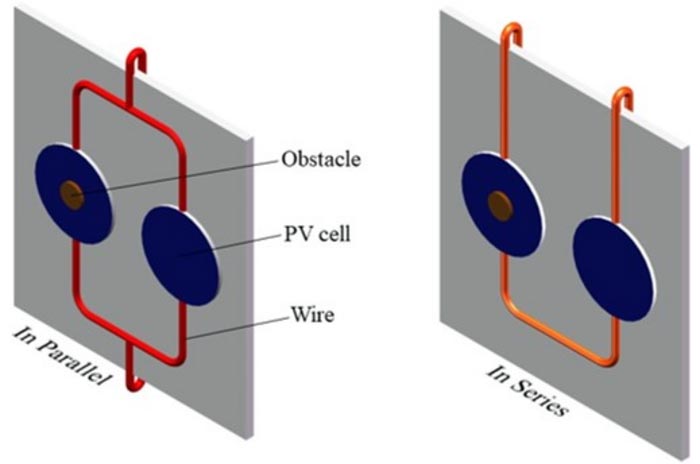Casting shadows on solar cells connected in series

Two solar cells connected in parallel (left) and in series (right) with an obstacle creating shade (brown). Shady conditions caused more power loss in series systems.
Credit: Guo et al.
In shaded conditions, photovoltaics linked end-to-end experience more power loss than cells running in parallel.
Large obstacles, like clouds and buildings, can block sunlight from reaching solar cells, but smaller sources, such as dust and leaves, can also create similar problems. Understanding how the loss of incoming radiation affects power output is essential for optimizing photovoltaic technology, which converts light into electricity and is an important contributor to the green energy transition.
In the Journal of Renewable and Sustainable Energy, by AIP Publishing, researchers from Shanghai Polytechnic University, Shanghai Engineering Research Center of Advanced Thermal Functional Materials, and Shanghai Solar Energy Research Center Co. Ltd explored how different shade conditions impact performance of single solar cells and two-cell systems connected in series and parallel.
“In the real world, photovoltaic cells are sometimes shaded by obstacles, which significantly alters the amount of incoming light,” said author Huaqing Xie, of Shanghai Polytechnic University and Shanghai Engineering Research Center of Advanced Thermal Functional Materials. “The degradation effects make power optimization difficult and result in significant power loss.”
Photovoltaics connected in series create a single path with the electrons flowing from one cell into the next. In contrast, cells in parallel provide two lanes for electrons to travel through, then recombine later. In practical applications, networks of solar cells are connected in series and parallel to expand the output current and power capability.
The team found that the decrease in output current of a single cell or two cells connected in parallel was nearly identical to the ratio of shade to sunlight. However, for two cells running in series, there was excess power loss and a rise in temperature, which can cause further output degradation. For example, with 29.6% of the series photovoltaic module in the shade, the current decreased by 57.6%.
“Our study indicates that many factors, including shadow area, shadows on different cells of the module, and the connection of cells and modules, may affect the performance,” said Xie.
Previous studies have explored the consequences of shade on large photovoltaic modules but have largely ignored single cells and simple systems.
“In these complicated systems, shadows on one single cell may play vital role on the system output and reliability,” said Xie. “Therefore, studying single cells or a simple arrangement of two connected cells is necessary for solar panel development.”
In the future, the authors hope to examine the microscopic interaction behaviors and mechanisms in photovoltaic cells subjected to different shadows.
The article “Experimental study on the power losses of a single photovoltaic cells and two series and parallel connected cells with partial shadows” is authored by Xiaoxue Guo, Jiapu Zou, Zihua Wu, Yuanyuan Wang, and Huaqing Xie. The article will appear in Journal of Renewable and Sustainable Energy on Sept. 27, 2022 (DOI: 10.1063/5.0106977). After that date, it can be accessed at https://doi.org/10.1063/5.0106977.
ABOUT THE JOURNAL
Journal of Renewable and Sustainable Energy is an interdisciplinary journal that publishes across all areas of renewable and sustainable energy relevant to the physical science and engineering communities. Topics covered include solar, wind, biofuels and more, as well as renewable energy integration, energy meteorology and climatology, and renewable resourcing and forecasting. See https://aip.scitation.org/journal/rse.
Journal: Journal of Renewable and Sustainable Energy
DOI: 10.1063/5.0106977
Article Title: Experimental study on the power losses of a single photovoltaic cells and two series and parallel connected cells with partial shadows
Article Publication Date: 27-Sep-2022
Media Contact
Wendy Beatty
American Institute of Physics
media@aip.org
Office: 301.209.3090
All latest news from the category: Power and Electrical Engineering
This topic covers issues related to energy generation, conversion, transportation and consumption and how the industry is addressing the challenge of energy efficiency in general.
innovations-report provides in-depth and informative reports and articles on subjects ranging from wind energy, fuel cell technology, solar energy, geothermal energy, petroleum, gas, nuclear engineering, alternative energy and energy efficiency to fusion, hydrogen and superconductor technologies.
Newest articles

Innovative 3D printed scaffolds offer new hope for bone healing
Researchers at the Institute for Bioengineering of Catalonia have developed novel 3D printed PLA-CaP scaffolds that promote blood vessel formation, ensuring better healing and regeneration of bone tissue. Bone is…

The surprising role of gut infection in Alzheimer’s disease
ASU- and Banner Alzheimer’s Institute-led study implicates link between a common virus and the disease, which travels from the gut to the brain and may be a target for antiviral…

Molecular gardening: New enzymes discovered for protein modification pruning
How deubiquitinases USP53 and USP54 cleave long polyubiquitin chains and how the former is linked to liver disease in children. Deubiquitinases (DUBs) are enzymes used by cells to trim protein…



